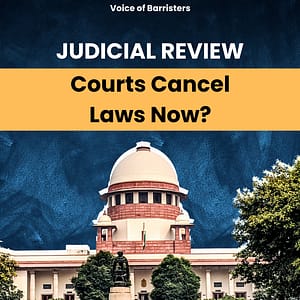Judicial Review: An assessment of the makers
8 min read
Introduction
Judicial review, the ability of a country’s courts to analyze the activities of the legislative, executive, and administrative branches of government and determine whether such actions are in accordance with the constitution.
The judicial review has been divided into three categories by Justice Syed Shah Mohammed Quadri: Constitutional amendments are subject to judicial scrutiny. Judicial scrutiny of Parliamentary and State Legislature legislation, as well as subordinate legislation.
Inconsistent actions are ruled unconstitutional and so null and void. In this sense, the institution of judicial review is dependent on the presence of a written constitution. We shall be understanding it in elaborated terms in this article.
Emergence of judicial review
Let us start from the very start of the constitutional judicial review. Constitutional judicial review is widely thought to have originated with John Marshall, the fourth Chief Justice of the United States (1801-35), asserting in Marbury v. Madison (1803), that the Supreme Court of the United States had the authority to nullify legislation enacted by Congress.
There was, however, no express foundation in the actual text of the United States Constitution for Marshall’s assertion of the power of judicial review; its eventual success hinged on the Supreme Court’s own ruling, as well as the absence of any political challenge to it.
While in India the concept of Judicial Review came as late as the 1970s. when the largest yet bench of 13 judges in the landmark case of his holiness Keshavnanda Bharti vs the State of Kerela (1970) in which it was held that any constitutional change that violates the Basic Structure of the Indian Constitution may be declared illegal by the courts.
Judicial review is frequently utilized to defend and enforce the Fundamental Rights granted by the Constitution. Judicial review is employed less frequently in problems of legislative competence involving center-state relations.
The Indian Parliament passed the Forty-second Amendment in response to the Kesavananda Bharati case in 1973. This was eventually addressed by the Supreme Court in the Minerva Mills case (1977), in which the Basic Structure Doctrine was clarified. Parts of the Amendment were declared unconstitutional because they limited the courts’ authority to evaluate constitutional amendments and accorded more weight to Directive Principles than Fundamental Rights.
The verdict established that, while Parliament can change the Constitution, it cannot undermine it. Under the Basic Structure Doctrine, the court upheld judicial review as a constitutionally protected component.
In conformity with the Indian Constitution, the legitimacy of judicial review has been solidly established. Notably, Article 13(2) of the Constitution specifically states that any law that is incompatible with the fundamental rights mentioned in Part III is void. This firm attitude validates the idea of judicial review.
Within the framework of the Indian Constitution, the legality of judicial review has gone uncontested. Early Indian judicial cases reinforced this inherent authority. The Indian Supreme Court specifically said that judicial review is an inherent feature of a written constitution. Importantly, this power exists independently of the provisions outlined in Article 13(2).
In essence, the historical notion of ultra vires serves to underlie the foundation of judicial review in India, which is strengthened by constitutional provisions and judicial affirmations.
On what grounds a judicial review is done?
Judicial review is used to guarantee that the activities of the government are in accordance with the Constitution and the values of justice, equality, fairness and to assess the legality.
Some of them are:
- Fundamental Rights Violation: Courts examine actions and legislation to ensure they do not violate the fundamental rights granted by the Indian Constitution, such as the right to equality, the right to life and personal liberty, freedom of speech and expression, and so on.
- Ultra Vires Acts: Judicial review is carried out to ensure that government acts and laws do not exceed the authority allocated to them by the Constitution or relevant statutes. If an action exceeds the authority granted, it can be ruled “ultra vires.”
- Violation of Directive Principles: While Directive Principles of State Policy are not immediately enforceable, they are crucial guides for governance. Judicial review guarantees that the activities of the government are consistent with these values.
- Arbitrariness and Unreasonability: Courts determine whether government decisions are arbitrary, irrational, or lack a rational foundation. A decision can be overturned if it appears to be without valid justification.
- Natural Justice Violation: Judicial review is done to ensure that proper procedures and natural justice principles are followed in administrative and quasi-judicial actions.
- Discrimination: Courts examine actions and legislation to ensure that they do not unfairly discriminate on the basis of characteristics like as gender, religion, caste, and so on.
- Violation of Separation of Powers: Judiciary review guarantees that each arm of government (legislative, executive, and judiciary) acts within its constitutionally specified area of authority.
- Legislative Competence: The courts determine whether a statute was passed within the authority’s legislative competence.
- Public Interest: Courts can step in to defend the public interest when actions or decisions threaten the general welfare or common good.
- Excess Delegation: Judicial review evaluates whether there has been an undue delegation of legislative power to the executive.
Judicial Review is not Judicial Restraint
At the first mention of either of the terms i.e. Judicial Review and Judicial Restraint one gets the impression that they are the same in the meaning as well but both have a vast stretch different legal meaning and implementation from their vantage points.
Starting of with the basic difference of definitions of Judicial Review and Judicial Restraint.
Judicial Review: Judicial review is a legal notion that relates to the ability of courts or judicial bodies to analyze and evaluate legislative and executive branch actions, decisions, and legislation.
Courts examine the constitutionality and legality of various activities and laws to ensure they are consistent with constitutional standards and values.
Judicial Restraint: Judicial Restraint is a theory judicial interpretation that encourages judges to display restraint in their own power It contends that judges should be hesitant to overturn legislation unless they are clearly unlawful.
Courts who are judicially restricted follow the principle of stare decisis, which is the principle of maintaining established precedent handed down by previous courts. It is based on a precise interpretation of the law as well as the significance of legal precedent.
And also it is based on the policy that the courts shall only interpret the law and shall not intercede the work of law making institutions.
In the landmark case of S.R.Bommai vs. Union of India: The court concluded that in certain cases, political aspects predominate and that judicial review is not possible. As stated in Article 356 of the Constitution, the exercise of authority was a political problem, and so no judicial involvement was required.
The Court said that developing norms that are judicially manageable for analyzing political judgments is difficult, and that if the courts intervene, they would be entering the political arena and so impugning political wisdom, which they must avoid at all costs.
The need of the scrutiny of Judicial Review
The primary goal of judicial review in India is to guarantee that all actions, decisions, and legislation taken by the legislative and executive arms of government are consistent with the concepts, values, and provisions specified in the Constitution.
This mechanism acts as a check and balance on the use of government authority, preventing any encroachment on individual rights and liberties and ensuring the democratic system’s integrity. In India, judicial review promotes justice, fairness, and the rule of law by ensuring that no branch of government acts beyond its constitutionally specified limitations.
There have been several such instances when after a law has passed by both the houses it is often not what is best for the peoples benefit but for that of benefit of some single authority or gain. That is why our constitution has provided us with the liberty of challenging such laws made by the government judicial review plays the crucial role in decoding the puzzle we as a society may find ourselves in the present times or the future.
One of the biggest example of judicial review that can be provided in todays time was the Farmers bill which had passed in September 2020 and was further repealed in 2021 which was known as The Farm Laws Repeal Bill 2021 .
A small background of the aforementioned bill.
Farmers’ Produce Trade Act: Allows farmers to sell outside of established marketplaces, promoting competition and choice in inter and intrastate trade.
Empowerment and Protection Bill: Creates a contract farming system for securing pre-agreed rates and resolving disputes.
Essential Commodities Amendment: Changes laws on specific crops in order to stimulate private investment and manage price swings.
These bills generated significant discussion and debate in India, with some farmers’ organizations and other stakeholders expressing concerns about potential negative impacts on farmers’ income and the role of government intervention in the agriculture sector.
As we know that the bill enraged the farmers and associations from all over the country several PILs were filed, and in the case of Rakesh Vaishnav & Ors v Union of India & Ors. the constitutionality of the Farm laws shall be governed.
Limitations of Judicial Review
The judiciary’s ability to exercise judicial review is limited. If the judiciary crosses the line by meddling with the executive’s mission, it results in judicial activism, which can lead to judicial overreach. Judicial Review limits the government’s ability to function.
Chief Justice Marshall ruled in the Marbury vs. Madison case that the Court should not assume jurisdiction if it does not have jurisdiction, but it must take jurisdiction if it does.
The Supreme Court and High Courts hold the authority for judicial review, excluding lower courts. Excessive interventions could undermine public confidence in government effectiveness. Courts ought to avoid interfering in political and policy issues, intervening only when necessary.
Judgments driven by personal motives have the potential to detrimentally affect the public. Judicial review must not violate legislative powers or supersede laws. India follows a functional separation of powers, not a strict one.
It is also necessary for the judicial review to follow the doctrine of “strict necessity“ which is a legal principle that states that in certain cases, actions or judgments that would otherwise be illegal or in violation of the law are acceptable if they are deemed absolutely necessary to prevent greater harm or achieve a key goal.
This doctrine is frequently invoked when there is an urgent need to diverge from established rules or laws in order to protect a basic interest or prevent an impending threat.
In very layman terms this ‘Strict Necessity’ standard binds the Court’s hands and forbids it from considering a law’s constitutional viability.
There are some implied limitations as well:
- Locus Standi: Article 32 petitions are typically limited to rights violation by individuals, but Public Interest Litigation (PIL) broadens this. Courts may overlook ‘locus standi’ for reviewing questionable decisions.
- Res Judicata: Court decisions should be binding and final. Once a petition is dismissed, it can’t be refiled on the same grounds in the same court.
- Unreasonable Delay: Seeking remedies under Articles 32 and 226 requires timely action. Courts may reject cases with significant delays or laches by parties, unless valid reasons are presented.
Conclusion
Judicial review is a critical component of modern democracies, assuring the legality of government actions and the protection of individual rights. While it is effective, it may be improved. Its impact could be refined by clarifying judicial involvement in policy topics, resolving court system delays, and exploring expanded access to proceedings. Adapting judicial review to changing societal requirements strengthens its role in upholding the rule of law and the governmental balance of powers.




